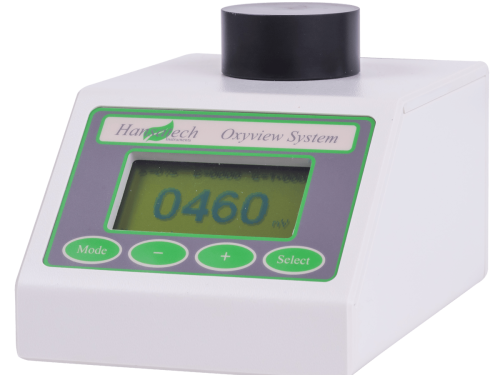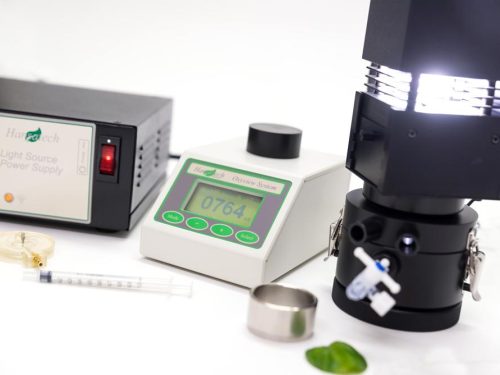S1 Oxygen Electrode Disc
Since its original design in the early 1970s by Tom Delieu and David Walker, the S1 Clark-type oxygen electrode disc remains largely unchanged – a true testament to the quality and reliability of the sensor. The S1 consists of a platinum cathode and silver anode set into an epoxy resin disc and is prepared for use by trapping a layer of 50% saturated KCl solution beneath an oxygen-permeable PTFE membrane. A paper spacer placed beneath the membrane acts as a wick to provide a uniform layer of electrolyte between anode and cathode.

When a small voltage is applied across these electrodes (with the platinum negative with respect to the silver), the current which flows is at first negligible and the platinum becomes polarised (i.e. it adopts the externally applied potential). As this potential is increased to 700 mV, oxygen is reduced at the platinum surface, initially to hydrogen peroxide H2O2 so that the polarity tends to discharge as electrons are donated to oxygen (which acts as an electron acceptor). The current which then flows is stoichiometrically related to the oxygen consumed at the cathode.

When connected to the electrode control unit, the S1 provides a fast, effective and accurate method of detecting small changes in oxygen concentration.
LD2/3 Electrode Chamber

The LD2/3 leafdisc electrode chamber allows oxygen uptake/evolution measurements to be performed from leafdiscs, excised needles, algae, mosses, lichens etc with a surface area of up to 10cm2. A prepared S1 oxygen electrode disc is mounted directly below the sample-chamber with the dome of the electrode forming the sample-chamber floor.
LD2/3 provides precision temperature control of sample and sensor via upper and lower water jackets fitted with self-sealing ports for connection to a thermoregulated circulating waterbath.
The LD2/3 is constructed from black acetal which provides the ability for dark adaptation of samples or oxygen measurement in complete darkness.
The sample-chamber section has 2 gas ports providing both a calibration and flow-through capability for rapid changes in the gaseous environment above the sample. An additional tapped and stoppered hole is provided for the introduction of an optional temperature sensor or similar auxiliary sensor.
A clear cast acrylic top window allows illumination of the sample via the LH36/2R LED light source with a further 16mm optical port for either additional illumination or insertion of a quantum sensor, etc. An additional port is orientated more steeply towards the sample and enables the fibre-optic cable from the FMS 1+ or FMS 2+ modulated fluorimeters to be positioned close to the sample allowing simultaneous measurement of chlorophyll fluorescence.
Oxylab+ Control Unit

The next generation Oxylab+ oxygen electrode control unit combines striking aesthetics with enhanced features and functionality offering significant advances in flexibility and performance over previous generations of electrode control unit. As part of a complete system, Oxylab+ provides a convenient yet powerful tool for measurements of oxygen evolution or uptake across a broad range of liquid-phase samples from chloroplast extractions to mitochondrial suspensions with oxygen concentrations up to 100%.
Oxylab+ offers unrivalled price vs. performance combining simplicity of operation with an enviable feature set. The outstanding flexibility ensures Oxylab+ is equally useful in both a teaching and research capacity. 24-bit resolution allows detection of minute changes in oxygen tension without needing to apply instrument gain. This results in beautiful, noise-free traces even when zoomed close in on areas of interest. Integral electronics provide control over an LED light source with automatic intensity changes handled by user-defined PFD light tables in software.
The system allows real-time graphing of signals from auxiliary inputs and ion-selective electrodes providing scope for comprehensive analysis of oxygen activity simultaneously with signals such as pH, TPP+, calcium, potassium and hydrogen ions. Signals from all inputs are additionally displayed on an LCD screen mounted within the front panel of the Oxylab+ control unit.
Up to 2 individual Oxylab+ control units may be linked to a single PC and operated simultaneously from OxyTrace+ software providing a powerful, multi-channel system.
LH36/2R LED Light Source

The LH36/2R light housing is designed specifically for use with the DW3 chamber. The light housing mounts directly on to the larger optical port of the DW3 and is held securely in place.
The large-area LED array consists of 36 red LEDs arranged in such a way to provide a high uniformity of illumination of laminar samples suspended in the square section chamber of the DW3.
LH36/2R connects directly to the rear of the Oxylab+ electrode control unit. Light intensity adjustments are made automatically based on user-defined PFD tables within OxyTrace+ software. PFD tables consist of up to 20 individual steps allowing complex light response assays to be configured for automatic execution during a measurement.
The LH36/2R has an integral cooling fan which automatically switches on to cool the housing when the light intensity reaches a certain point. This provides stability control of the light intensity when required at higher light intensity steps. Optical feedback controls within the light housing serves to enhance the stability of the LH36/2R performance across the entire range of intensity.
The graph below shows the spectral output of the LH36/2R light source.

The LH36/2R has a peak wavelength centred at 660nm with a maximum intensity of 900 µmol m-2 s-1 in DW3.
QSRED Quantum Sensor
QSRED Quantum Sensor

The QSRED quantum sensor consists of a handheld display unit and matched cosine corrected sensor head containing a special high-grade photocell filtered for the 550nm – 750nm waveband. The μmol m-2 s-1 value from the sensor is displayed on the LCD display. 3 measurement ranges allow maximum sensitivity from 0 μmol m-2 s-1 – 2,000 μmol m-2 s-1.
QSRED is supplied with the Leaflab 2+ system to assist with effective calibration of the LH36/2R light source. Each unit is supplied with an individual certificate showing that system calibration has been carried out against a National Physical Laboratory (NPL) calibrated reference lamp.
System Components
Leaflab 2+ systems are supplied with the following components:
- OXYL1+: Oxylab+ electrode control unit
- LD2/3: Oxygen electrode chamber
- S1: Oxygen electrode disc and SMB-SMB connection cable
- LH36/2R: LED light source
- QSRED: Red filetered quantum sensor
- A2: Membrane applicator to assist with smooth application of electrode membrane
- S4: PTFE membrane (0.0125mm x 25mm x 33m)
- S9B: Set of replacement O-rings for LD2/3 electrode chamber
- S14: Set of 3 stainless steel discs, capillary matting and foam spacer for leafdisc electrode chambers
- S15: 3-way gas taps and 1ml disposable syringe for leafdisc electrode chambers (4 taps + 2 syringes)
- S16: Cleaning kit for the S1 electrode disc.
Technical Specifications
Oxylab+ electrode control unit
- Measuring range:
- O2: 0% – 100%
- pH: 0pH – 14pH
- Aux: 0V – 4.096V
- Signal inputs:
- S1 O2 electrode (SMB)
- pH/ISE (BNC)
- Aux (8-pin mini-Din)
- QTP1+ PAR/temp probe (6-pin mini-Din)
- Resolution:
- O2: 0.0003% (24-bit)
- pH: 0.0006pH (16-bit)
- Aux: 62.5µV/bit (16-bit)
- Polarising voltage: 700mV
- Input sensitivity: 0nA – 9,000nA
- Magnetic stirrer: Software-controlled 150rpm – 900rpm in % steps
- Sampling rate: 0.1 readings/s – 10 readings/s
- Electronics:
- Microcontroller: 16-bit high-performance CPU running at 32 MHz
- ADC: Dual, low-power
- 16/24-bit Sigma Delta
- Display: 61 x 2 character blue LCD
- Communications: USB 2.0
- Analogue output: 0V – 4.5V O2 signal
- Dimensions (HWD): 250mm x 125mm x 65mm
- Weight: 630g
- Power: 95V – 260V universal input mains supply. Output 12V DC 2.5A
LD2/3 electrode chamber
- Suitability: Gas-phase photosynthesis/respiration
- Construction: Black acetal
- Sample Chamber: Leaf chamber (7.5cc)
- Sample Area: 10cm2
- Optical Ports: Cast acrylic top window, optical port (16mm dia) and fluorimetry port for FMS 1+ & FMS 2+ modulated fluorimeters
- Temperature Control: Double water jacket connected to circulating water bath
- Dimensions (DH): 100mm x 130mm
- Weight: 650g.
S1 oxygen electrode disc
- Electrode type: Clark-type polarographic oxygen sensor
- Electrode output: Typically 1.6µA at 21% O2
- Residual current: Typically 0.04µA in 0% O2
- Response time: 10 – 90% typically <5 seconds
- Oxygen consumption: Typically <0.015µmol/hr-1
LH36/2R light source
- Light source: 36 red LED array
- Control: Via Oxylab+ and OxyTrace+ software
- Wavelength: 660nm peak wavelength
- Cooling: Integral automatic cooling fan
- Intensity: max. 900 µmol m-2 s-1
- Dimensions: 74mm x 52mm
- Weight: 270g
QSRED quantum sensor
- Measuring Range: 0 μmol m-2 s-1 – 2,000 μmol m-2 s-1 in 3 ranges (0 μmol m-2 s-1 – 20.00 μmol m-2 s-1, 0 μmol m-2 s-1 – 200.0 μmol m-2 s-1, 0 μmol m-2 s-1 – 2,000 μmol m-2 s-1) in the 550nm – 750nm waveband
- Resolution:
- 1 μmol m-2 s-1 at 0 μmol m-2 s-1 – 2,000 μmol m-2 s-1
- 0.1 μmol m-2 s-1 at 0 μmol m-2 s-1 – 200.0 μmol m-2 s-1
- 0.01 μmol m-2 s-1 at 0 μmol m-2 s-1 – 20.00 μmol m-2 s-1
- PAR Sensor: Silicon photodiode/optical filter combination with white acetal diffuser (37mm dia.)
- Signal Display: Hand-held display unit with LCD. 0V – 2V analogue output of measured values
- Power Requirement: 1 x 9V PP3 cell
- Dimensions Display (HWD): 146mm x 78mm x 35mm
- Weight: 238g (including battery).
Publications
One of the extensions of the Google search facility is Google Scholar. It allows you to search through vast archives of peer-reviewed published papers and journals that have been posted online.
Use the tool below to enter search terms as required. As an example, hansatech instruments Leaflab 2+ System has already been entered into the search box. Press the "Search" button to view the Google Scholar results for this search string.
Admittedly, some of the results link to journals which require subscription in order to view the publications but even so, we have found this facility to be a valuable tool.


















